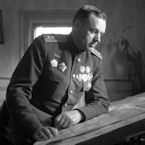janh
Posts: 1216
Joined: 6/12/2007
Status: offline

|
quote:
ORIGINAL: Bletchley_Geek
Common practice in wargaming is to assign victory levels according to performance better than historical.
Hmmh, perhaps you ought to figure in the potential of improvement of both sides into the VP conditions. Both sides made huge misjudgements and errors, and it is hard to guess whether the Soviets or the Axis would have more potential to learn from hindsight and lack of medelling by Hitler or Stalin, or their staffs and officers with own politics going on. It even depends on the time: certainly the Axis could have done little better in 41 with the exception of the Leningrad hold order, and perhaps or not the delay of Typhoon for Kiev, but the Soviets could do a lot better by running rather than desperately learning many times that fighting mobile forces without proper means leads to huge, wasteful pockets. Later, also Axis has a lot of potential to avoid mistakes.
An extreme example would be applying above rule to the battle of Chancellorsville. Given that this was perhaps a one-time feat, it is hard to image that any Confederate player could even get anywhere near the historical result. Hence, a "performance better than historical" is perhaps not a good argument alone.
quote:
ORIGINAL: Bletchley_Geek
As I see WitE right now, things are rigged so that the Axis player - no matter how weak or strong - achieves similar gains to those achieved by Nazi Germany by December 1941. Hence why we'll hardly see any Axis player suffering the nearly 500,000 casualties (permanent and temporary) suffered historically by the combined Axis Armies between 22nd June - 1st September. That's the reason why will never see Southwestern Front more than holding their ground against the massed forces of AGS 6th, 17th and 1st PzGroup. That's why there isn't anything like the Smolensk battles between July and August 1941 in the game.
And the converse is true for the Soviets. The game is rigged from 1943 onwards. The German Army loses quality even if it doesn't suffer anything like the Winter 1942-43 disasters or 1941-42 attrition rates.
That's what it seems like. The transitions, forced by both the optional rules such as the 41 blizzard rules, the new snow rules, and the national moral changes, are quite quick and feel abrupt. Too abrupt? All these detail, extra situational rules are becoming hard to remember, are getting too many. Things should develop naturally from the situation, making it easier to understand and play.
For example, I would wish the strong blizzard offensives would come about due to the Soviets gaining more strength by reinforcements, the Siberian Divisions, and by a naturally tightening German supply situations due to snow and severe weather inhibiting road and railway traffic combined with overextension and exhaustion. The transition of initiative would be more continuous, and offensives would trickle out rather than be immediate -- the latter which allows a gamey exploitation, especially with fixed weather, as player know perfectly when to pull divisions back to Germany, or stop the blizzard counteroffensive and run for the trenches again.
Unfortunately, as it stands now, the Soviet counters in 41 are in little condition to counterattack unless massed against single or isolated German units. All the counterattacks on a smaller scale, or the hard counterattacks against AGS and its tedious advance are not represented due to poor Soviet quality, Lvov, lack of reaction mode combined with very fast mobile/Panzer speeds, etc. You cannot blame a Soviet player not to fight forward more than evacuations necessitate with that.
I will try a game against Soviet AI next in which it gets a 130% morale bonus for summer 1941, and see whether that leads to some counterattacking...
|
 Printable Version
Printable Version





















 New Messages
New Messages No New Messages
No New Messages Hot Topic w/ New Messages
Hot Topic w/ New Messages Hot Topic w/o New Messages
Hot Topic w/o New Messages Locked w/ New Messages
Locked w/ New Messages Locked w/o New Messages
Locked w/o New Messages Post New Thread
Post New Thread